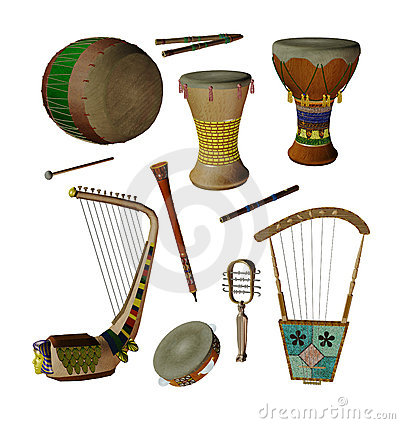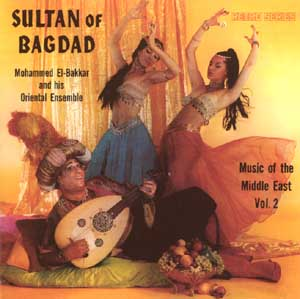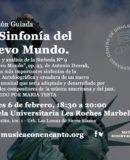Music in the Middle East
Music in the Middle East
This is a subject that would need many pages beyond the scope of this publication but It could be informative and interesting in short summary as well. I would need to concentrate on the most popular instruments in these countries. Instruments of Ancient Mesopotamia and Egypt include the harp, the lyre, the Oud, the reed flute and the hand drum. As shown in this image.
 The Oud is the most important and popular instrument of music. This instrument and the Lute in Europe are of similar origins. The meaning of Oud is a small thin piece of wood which could have referred to the wooden plectrum used in playing the Oud. It is most likely this instrument was introduced to Europe during the Islamic period in the Iberian Peninsula (Andalusia). Its history can go back thousands of years, to Babylonia and at a later period to the 18th dynasty in Egypt.
The Oud is the most important and popular instrument of music. This instrument and the Lute in Europe are of similar origins. The meaning of Oud is a small thin piece of wood which could have referred to the wooden plectrum used in playing the Oud. It is most likely this instrument was introduced to Europe during the Islamic period in the Iberian Peninsula (Andalusia). Its history can go back thousands of years, to Babylonia and at a later period to the 18th dynasty in Egypt.
The Oud is without frets , that can be seen in the guitars and similar instruments, and at the same time all its strings converge together at the peg box end. The modern Oud has 5 pairs of strings and a single string. This development was a necessary changes in the 12th century to accommodate for the developing music of the time in this area.
Since the 19th century, the Oud became the social musical instrument for all occasions. The most famous of all the Oud players was Farid AlAtrash (1905-1974) who was Lebanese – Syrian and spent all his musical productive life in Egypt. This link shows one of his recordings in 1960 playing what is called taqasim. Taqasim means the improvising and personal interpretation of the instrumentalist in accordance to a strict pre-established rules and conventions. This is highly recognised and appreciated among the audience as a highly creative work.
Supported by the Oud, there is a certain type of singing, mainly in Iraq, which is called Maqam. This video link below shows, is unique in talents of Iraqi musicians. Please imagine the following combination of talents. Playing the Oud was Munir Bashir (1930-1997), Christian, and the singer was Nathom Al ghazali,(1921-1963) Muslem. Alghazali was married to the much loved and famous Iraqi Jewish singer named Salima Pasha Murad . Salima was the only known female to be titled Pasha showing respect and admiration. She died in Baghdad in 1974. The poem is by Al Mutanabbi (915-965 AD) who is considered to be the greatest of the Arabic poets..
This type of song is known as a Maqam, means “stand”, is sang here as Maqam Ajam meaning in do major. There are many types of Maqams. The Maqam style of singing is said to be the origin of the Spanish Flamenco..
http://www.youtube.com/watch?v=9aX04Rgi5mM&feature=related
The Harp
It is said that the music was created in Egypt among their gods thousands of years ago. In Egypt, some of the earliest images of bow harps are from the Pharaoh’s tombs dating some 5,000 years ago One of their famous instruments was the Lyre Harp which came to existence before 3000 BC. The Lyre could be the origin of the Irish / Celtic Harp that symbolizes Ireland. Today the Sufi Dhikir, meaning the repeating the name of God, is the closest contemporary music that relates to the ancient music of Egypt.
The instruments used in Egypt are numerous and include many of those used in modern orchestra instruments in Europe. The Egyptians listen to the normal pop music, in Arabic, while enjoying the traditional music in happy festivals or weddings.
Most of the Christian Copts music is related to church hymns and chants.
Egyptian singers and musicians are well respected and admired all over the Middle East. Two of the most famous are Um Khalthoom and Abdul Wahab. They composed the music and sang romantic Arabic poems relating frequently to impossible love.
Flutes and hand drums
Today the most popular music with the tourists in Egypt are belly dancers, dancing to the rhythms of the hand drum. The hand drum is also called the Dounbuk or Daff or Durbahha. This link is of Soheir Zaki, one of the most famous of the Egyptian belly dancers. Soheir is dancing to the sound of the beating hand drums and the local flute. Such evenings are common on happy occasion all over Egypt and for the tourist trade .
http://www.youtube.com/watch?v=HfRATlwjxqo
We wish you a happy and joyful New Year
Nael Marar
Disclaimer: The views, opinions and positions expressed within this guest article are those of the author Nael George Marar alone and do not represent those of the Marbella Marbella website. The accuracy, completeness and validity of any statements made within this article are not guaranteed. We accept no liability for any errors, omissions or representations. The copyright of this content belongs to Nael George Marar and any liability with regards to infringement of intellectual property rights remains with the author.
















The opinions expressed by individual commentators and contributors do not necessarily constitute this website's position on the particular topic.